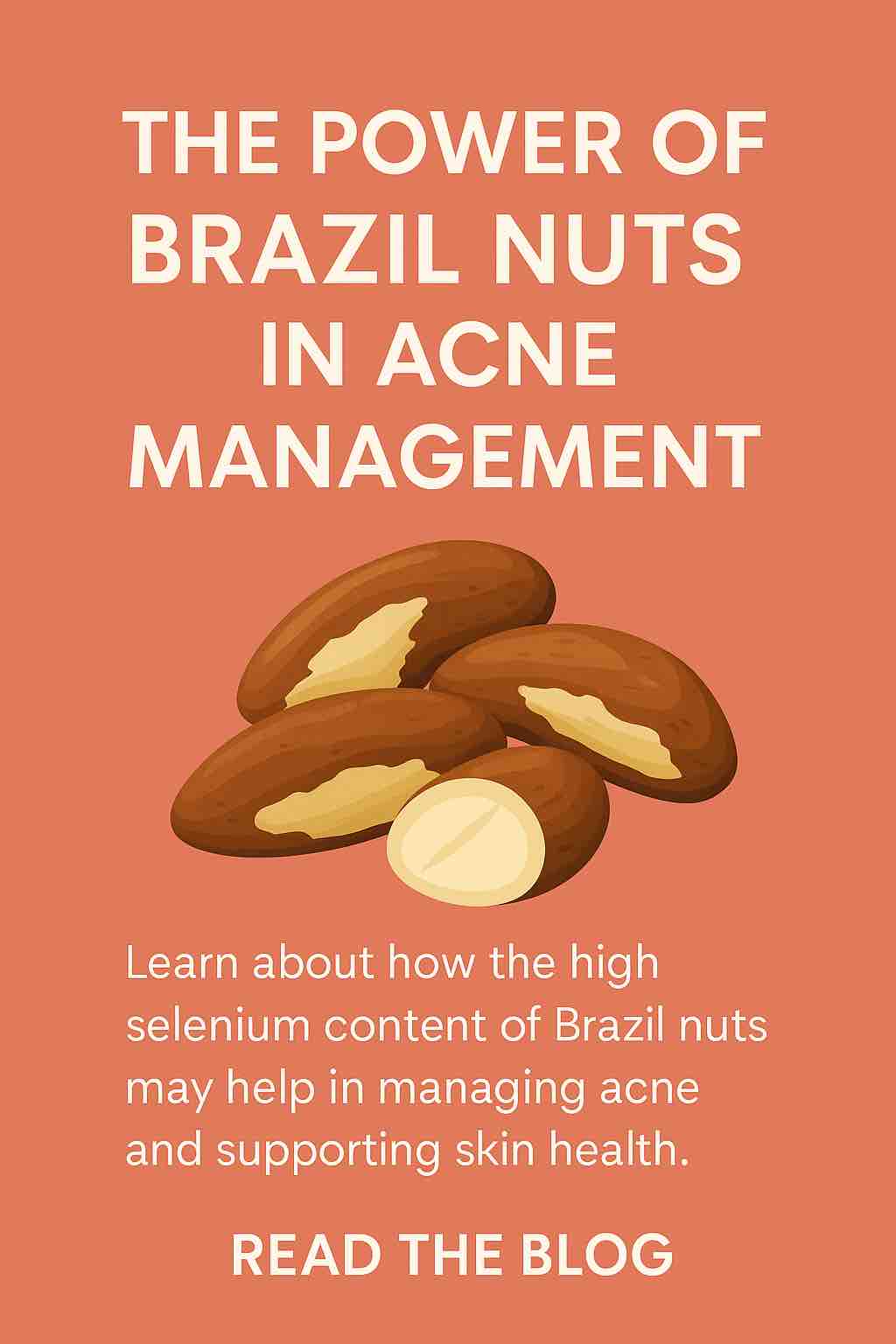
Acne is more than just a teenage rite of passage — it’s a complex skin condition that can persist well into adulthood, affecting self-esteem, emotional wellbeing, and quality of life. While countless creams, cleansers, and treatments flood the skincare market, more people are beginning to explore the role of nutrition in maintaining clear, healthy skin.
One superfood that has quietly gained attention in skin health discussions is the humble Brazil nut. At first glance, it may seem unassuming, but this Amazonian seed holds a powerful nutrient that could play a pivotal role in acne management: selenium.
In this post, we’ll explore the nutritional science behind Brazil nuts, their role in acne treatment, and how to integrate them safely into your diet.
The Link Between Nutrition and Acne: Why It Matters
Before diving into the specifics of Brazil nuts, it’s important to understand the growing consensus in scientific and dermatological communities that diet impacts acne. While acne is multifactorial — influenced by hormones, genetics, inflammation, and bacteria — diet can play a crucial role in exacerbating or alleviating its severity.
Emerging research indicates that inflammation, oxidative stress, and insulin spikes from high-glycemic foods contribute significantly to acne development. Nutrients that regulate inflammation, support immune function, and stabilize hormones have become the focal point of dietary acne interventions.
This brings us to selenium — and more specifically, to one of its most concentrated food sources: Brazil nuts.
Brazil Nuts: A Nutritional Powerhouse
Brazil nuts, native to the Amazon rainforest, are rich in several nutrients, but they are exceptionally high in selenium, a trace mineral known for its antioxidant and anti-inflammatory properties.
Nutritional Highlights (per 1 nut):
- Selenium: ~90 mcg (163% of the recommended daily intake)
- Vitamin E: Supports skin hydration and barrier function
- Zinc: A known anti-acne mineral
- Magnesium, Copper, and Healthy Fats: Contribute to overall skin health
Selenium and Skin Health: What the Science Says
Selenium is vital to the body’s antioxidant defense system. It forms part of key enzymes like glutathione peroxidase, which helps neutralize free radicals and reduces oxidative stress. Why is this important for acne?
1. Fights Inflammation
Acne is, at its core, an inflammatory condition. From clogged pores to pus-filled cysts, inflammation is behind much of the redness, swelling, and pain. Selenium’s ability to reduce inflammatory markers can calm the skin from within.
2. Supports Immune Regulation
An overactive or underperforming immune response can worsen acne. Selenium helps regulate immune function, aiding in the appropriate response to skin bacteria like P. acnes.
3. Balances Hormones
Hormonal imbalances, particularly androgens like testosterone, are closely linked to acne flares. While selenium doesn’t directly alter hormones, it supports thyroid function, which in turn influences hormone balance and metabolism.
4. Reduces Scarring and Supports Healing
By accelerating tissue repair and reducing oxidative damage, selenium may also contribute to faster healing of acne lesions and less post-acne scarring.
What Does the Research Say?
Several studies and reviews have linked low selenium levels to acne severity:
- A 2012 study published in Advances in Dermatology and Allergology found that individuals with acne had lower serum selenium levels compared to those with clear skin. Supplementation improved acne in combination with other antioxidants like vitamin E.
- Another review in the Journal of Clinical and Aesthetic Dermatology emphasized the role of antioxidant therapy, including selenium, in improving treatment outcomes for inflammatory acne.
While more controlled clinical trials are needed to isolate selenium’s specific impact, the current body of evidence suggests a promising supportive role.
How to Use Brazil Nuts Safely
Here’s where caution is important: Brazil nuts are extremely high in selenium, and more is not always better. Excessive intake can lead to selenium toxicity, which causes symptoms like:
- Nausea
- Fatigue
- Hair loss
- Nerve issues
- A characteristic garlic-like breath odor
How Many Brazil Nuts Should You Eat?
Just 1 to 2 nuts per day are sufficient — and likely optimal — to support skin health without crossing into dangerous territory. For most people, this provides more than the daily requirement of selenium while leaving a buffer below the tolerable upper limit (400 mcg/day).
Tips for Including Brazil Nuts in Your Diet
Brazil nuts are versatile and can be enjoyed in many ways:
- Eat 1–2 raw nuts as a snack
- Chop and sprinkle over oatmeal or yogurt
- Add to smoothies for a creamy texture
- Blend into homemade granola or trail mix
Avoid roasting at high temperatures, as this can degrade some of the healthy fats and nutrients. Raw or lightly toasted is best.
Final Thoughts: A Small Nut With a Big Impact
The journey to clearer skin isn’t always found in a bottle. Sometimes, it’s in the simple choices we make at the dining table.
Brazil nuts offer a compelling, evidence-backed case for being part of a nutritional strategy to combat acne. Their high selenium content, coupled with other skin-friendly nutrients, makes them a worthy ally in your skincare routine — from the inside out.
That said, acne is a complex condition, and no single food is a cure-all. Brazil nuts should complement a balanced, low-inflammatory diet, good skincare hygiene, and, when necessary, professional dermatological care.
So the next time you’re considering ways to support your skin health naturally, remember: sometimes, big changes can come in small (nut) packages.
FAQs
❓ 1. How do Brazil nuts help with acne?
Brazil nuts help manage acne primarily due to their high selenium content, which reduces inflammation, supports immune function, and fights oxidative stress—all of which contribute to clearer skin.
❓ 2. How many Brazil nuts should I eat per day for skin benefits?
One to two Brazil nuts per day is sufficient to meet your daily selenium needs. Eating more can lead to selenium toxicity, so moderation is key.
❓ 3. Can selenium from Brazil nuts replace acne medication?
No. Brazil nuts can complement acne treatments but should not replace prescribed medication. Always consult a healthcare provider before changing your treatment plan.
❓ 4. Are Brazil nuts better than selenium supplements for acne?
Yes, in many cases. Brazil nuts offer a natural, food-based source of selenium along with other skin-beneficial nutrients like vitamin E and healthy fats. However, supplements may be recommended if you’re allergic to nuts or need precise dosing.
❓ 5. How quickly will I see results on my skin after eating Brazil nuts?
Visible changes can take several weeks to months. Skin cell turnover typically occurs every 28–40 days, so consistent dietary changes take time to show.
❓ 6. Can eating too many Brazil nuts make acne worse?
Yes. Too much selenium can trigger side effects such as hormonal imbalance or skin irritation in rare cases. Stick to the safe limit (1–2 nuts daily).
❓ 7. Are there other foods that support acne reduction like Brazil nuts?
Yes. Zinc-rich foods (like pumpkin seeds), vitamin A sources (like sweet potatoes), and omega-3s (like salmon or flaxseeds) are also beneficial for acne-prone skin.
❓ 8. Are Brazil nuts safe for everyone to eat?
Most people can eat them, but those with nut allergies or thyroid disorders should consult a doctor before adding them to their diet due to selenium’s effect on thyroid function.
❓ 9. What’s the best time to eat Brazil nuts for skin health?
There’s no specific time, but eating them with other foods may help nutrient absorption, especially fats and fat-soluble vitamins like E.
❓ 10. Do roasted Brazil nuts still have the same skin benefits?
Roasted nuts lose some nutrient potency, especially if overcooked. Opt for raw or lightly toasted Brazil nuts to retain the maximum selenium and antioxidant content.










